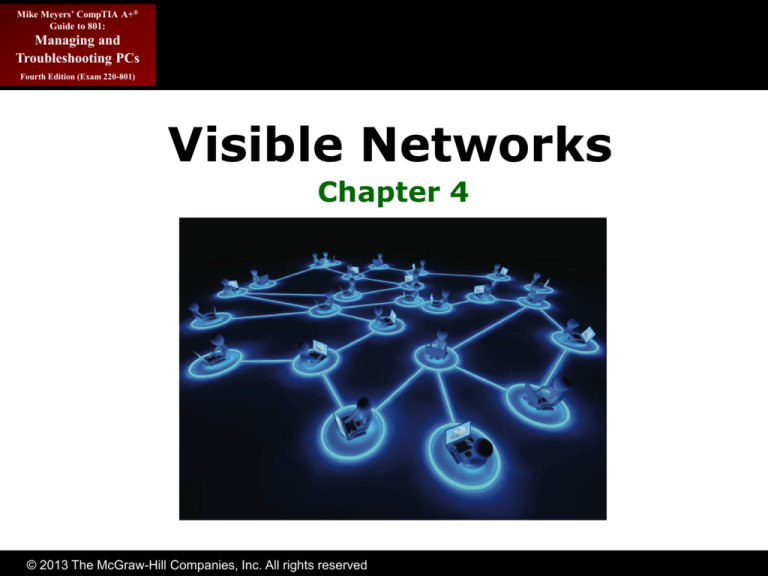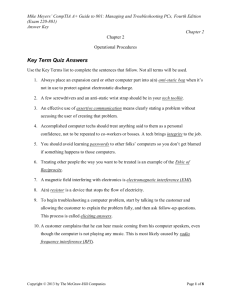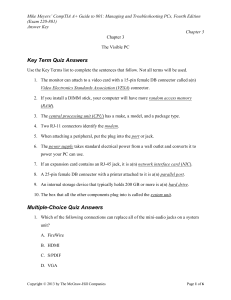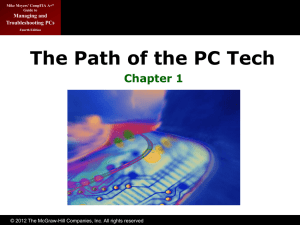
Mike Meyers’ CompTIA A+®
Guide to 801:
Managing and
Troubleshooting PCs
Fourth Edition (Exam 220-801)
Visible Networks
Chapter 4
© 2013 The McGraw-Hill Companies, Inc. All rights reserved
Mike Meyers’ CompTIA A+®
Guide to 801:
Managing and
Troubleshooting PCs
Overview
Fourth Edition (Exam 220-801)
• In this chapter, you will learn how to
– Describe the basic functions of a network, including
identifying common devices and connectors
– Discuss the differences between a LAN and a WAN
and the importance of TCP/IP
– Perform basic resource sharing
© 2013 The McGraw-Hill Companies, Inc. All rights reserved
Mike Meyers’ CompTIA A+®
Guide to 801:
Managing and
Troubleshooting PCs
What do you do on a network?
Fourth Edition (Exam 220-801)
Figure 1: Accessing remote computers
© 2013 The McGraw-Hill Companies, Inc. All rights reserved
Mike Meyers’ CompTIA A+®
Guide to 801:
Managing and
Troubleshooting PCs
Fourth Edition (Exam 220-801)
What do you do on a network?
(continued)
Figure 2: Accessing a Web page
© 2013 The McGraw-Hill Companies, Inc. All rights reserved
Mike Meyers’ CompTIA A+®
Guide to 801:
Managing and
Troubleshooting PCs
Fourth Edition (Exam 220-801)
What do you do on a network?
(continued)
Figure 3: Accessing a YouTube page
© 2013 The McGraw-Hill Companies, Inc. All rights reserved
Mike Meyers’ CompTIA A+®
Guide to 801:
Managing and
Troubleshooting PCs
Fourth Edition (Exam 220-801)
What do you do on a network?
(continued)
Figure 4: Sharing a printer in Windows 7
© 2013 The McGraw-Hill Companies, Inc. All rights reserved
Mike Meyers’ CompTIA A+®
Guide to 801:
Managing and
Troubleshooting PCs
Fourth Edition (Exam 220-801)
Network Technologies
© 2013 The McGraw-Hill Companies, Inc. All rights reserved
Mike Meyers’ CompTIA A+®
Guide to 801:
Managing and
Troubleshooting PCs
Network Technologies
Fourth Edition (Exam 220-801)
Figure 5: A typical network
© 2013 The McGraw-Hill Companies, Inc. All rights reserved
Mike Meyers’ CompTIA A+®
Guide to 801:
Managing and
Troubleshooting PCs
Topology
Fourth Edition (Exam 220-801)
• Topology is the physical and logical
design for the network to connect all of
the computers together.
• The most common network topologies
are called bus, ring, star, and mesh.
– In a bus topology, all computers connect to the
network via a main line called a bus cable.
– In a ring topology, all computers on the network
attach to a central ring of cable.
– A star topology has all of the computers on the
network connecting to a central wiring point
(usually called a switch).
© 2013 The McGraw-Hill Companies, Inc. All rights reserved
Mike Meyers’ CompTIA A+®
Guide to 801:
Managing and
Troubleshooting PCs
Topology (continued)
Fourth Edition (Exam 220-801)
• Topologies (continued)
– A mesh topology connects each computer to every other
computer via a dedicated line.
– There are also hybrid topologies, such as star bus or star
ring, which combine aspects of more than one topology.
• Make a clear distinction between the logical
and physical topology of a network.
– The logical topology is how the network is laid out on
paper, with nice straight lines and boxes, similar to an
electronic schematic.
– The physical topology describes the actual physical
layout of the computer network, with cables running
diagonally through the ceiling space or snaking their way
through walls.
© 2013 The McGraw-Hill Companies, Inc. All rights reserved
Mike Meyers’ CompTIA A+®
Guide to 801:
Managing and
Troubleshooting PCs
Topology (continued)
Fourth Edition (Exam 220-801)
Figure 6: Clockwise from top left: bus, ring, mesh, and star topologies
© 2013 The McGraw-Hill Companies, Inc. All rights reserved
Mike Meyers’ CompTIA A+®
Guide to 801:
Managing and
Troubleshooting PCs
Topology (continued)
Fourth Edition (Exam 220-801)
• A network technology:
– Is a practical application of a topology and other
critical standards to provide a method to get data
from one computer to another on a network.
– Defines many aspects of a network, from the
topology to the frame type, cabling, and
connectors used—everything necessary to get data
from one computer to another.
© 2013 The McGraw-Hill Companies, Inc. All rights reserved
Mike Meyers’ CompTIA A+®
Guide to 801:
Managing and
Troubleshooting PCs
Frames and NICs
Fourth Edition (Exam 220-801)
• Data is moved from one PC to another in
discrete chunks called frames.
• All NICs have a built-in identifier:
– A binary address unique to that single network
card, called a media access control (MAC) address
– The MAC address is 48 bits long, providing more
than 281 trillion MAC addresses.
– MAC addresses are binary, but we represent them
by using 12 hexadecimal characters.
– MAC addresses are burned into every NIC, and
some NIC makers print the MAC address on the
card.
© 2013 The McGraw-Hill Companies, Inc. All rights reserved
Mike Meyers’ CompTIA A+®
Guide to 801:
Managing and
Troubleshooting PCs
Frames and NICs (continued)
Fourth Edition (Exam 220-801)
Figure 7: MAC address
© 2013 The McGraw-Hill Companies, Inc. All rights reserved
Mike Meyers’ CompTIA A+®
Guide to 801:
Managing and
Troubleshooting PCs
Frames and NICs (continued)
Fourth Edition (Exam 220-801)
• Frames contain:
– The MAC address of the network card to which the
data is being sent
– The MAC address of the network card that sent the
data
– The data itself (varies in size depending on the
type of frame)
– A data check to verify that the data was received in
good order—called a cyclic redundancy check
(CRC)
• Frames must match the type of cabling,
connectors, and devices on the network
that carries them.
© 2013 The McGraw-Hill Companies, Inc. All rights reserved
Mike Meyers’ CompTIA A+®
Guide to 801:
Managing and
Troubleshooting PCs
Frames and NICs (continued)
Fourth Edition (Exam 220-801)
Figure 8: Generic frame
© 2013 The McGraw-Hill Companies, Inc. All rights reserved
Mike Meyers’ CompTIA A+®
Guide to 801:
Managing and
Troubleshooting PCs
Introducing Ethernet
Fourth Edition (Exam 220-801)
• Digital Equipment, Intel, and Xerox
– Invented the first network in the mid-1970s and
created what eventually became the Ethernet
standard
• Ethernet has gotten faster and used
different types of cabling, resulting in
sub-flavors of Ethernet—but ALL flavors
use the same frame type.
– All three use a star bus topology and usually
connect via a type of cable called unshielded
twisted pair (UTP).
© 2013 The McGraw-Hill Companies, Inc. All rights reserved
Mike Meyers’ CompTIA A+®
Guide to 801:
Managing and
Troubleshooting PCs
Fourth Edition (Exam 220-801)
Introducing Ethernet
(continued)
• Modern Ethernet networks all use star
bus topology.
– Combines characteristics of both star and bus
– Bus isn’t actually a long cable—it’s been shrunk down
and put in the box
– PCs connect via network ports on switch or hub
– Hubs make all computers share a given bandwidth
– Switches improve bandwidth—each PC on its own
separate network
– Connection between a computer and a switch is a
segment—segments are limited to ~100 meters
– Star bus network doesn’t go down if a single cable
breaks—but it does if the switch or hub breaks
© 2013 The McGraw-Hill Companies, Inc. All rights reserved
Mike Meyers’ CompTIA A+®
Guide to 801:
Managing and
Troubleshooting PCs
Fourth Edition (Exam 220-801)
Introducing Ethernet
(continued)
Figure 9: Star bus
© 2013 The McGraw-Hill Companies, Inc. All rights reserved
Mike Meyers’ CompTIA A+®
Guide to 801:
Managing and
Troubleshooting PCs
Fourth Edition (Exam 220-801)
Introducing Ethernet
(continued)
Figure 10: A switch
© 2013 The McGraw-Hill Companies, Inc. All rights reserved
Mike Meyers’ CompTIA A+®
Guide to 801:
Managing and
Troubleshooting PCs
Fourth Edition (Exam 220-801)
Introducing Ethernet
(continued)
• Unshielded Twisted Pair
– Unshielded twisted pair (UTP)—specified cabling for
10/100/1000BaseT and the predominant cabling system
used
– Different types of twisted pair cabling are available for
the needs of different networks.
– Twisted pair is AWG 22- to 26-gauge wire twisted
together into color-coded pairs. Each wire is individually
insulated and encased as a group in a common jacket.
– CAT Levels—UTP cables come in categories that define
the maximum speed at which data can be transferred
(also called bandwidth). Major categories include CAT 1,
3, 5, 5e, 6, and 6a.
© 2013 The McGraw-Hill Companies, Inc. All rights reserved
Mike Meyers’ CompTIA A+®
Guide to 801:
Managing and
Troubleshooting PCs
Fourth Edition (Exam 220-801)
Introducing Ethernet
(continued)
• UTP cables come in categories that
define the maximum speed at which data
can be transferred (bandwidth). The
major categories (CATs) are as follows:
CAT 1
Standard telephone line
CAT 3
Designed for 10-Mbps networks; a variant that used all four pairs of
wires supported 100-Mbps speeds
CAT 5
Designed for 100-Mbps networks
CAT 5e
Enhanced to handle 1000-Mbps networks
CAT 6
Supports 1000-Mbps networks at 100-meter segments; 10-Gbps
networks up to 55-meter segments
CAT 6a
Supports 10-Gbps networks at 100-meter segments
© 2013 The McGraw-Hill Companies, Inc. All rights reserved
Mike Meyers’ CompTIA A+®
Guide to 801:
Managing and
Troubleshooting PCs
Fourth Edition (Exam 220-801)
Introducing Ethernet
(continued)
• Unshielded Twisted Pair (continued)
– The Telecommunication Industry
Association/Electronics Industries Alliance
(TIA/EIA) establishes the UTP categories, which fall
under the TIA/EIA 568 specification. Currently,
most installers use CAT 5e or CAT 6 cable.
• Shielded Twisted Pair (STP)
– Consists of twisted pairs of wires surrounded by
shielding to protect them from EMI, or
electromagnetic interference
– Rare to see, used only in locations with excessive
electronic noise or areas requiring very high
security
© 2013 The McGraw-Hill Companies, Inc. All rights reserved
Mike Meyers’ CompTIA A+®
Guide to 801:
Managing and
Troubleshooting PCs
Fourth Edition (Exam 220-801)
Introducing Ethernet
(continued)
Figure 11: Cable markings for CAT level
© 2013 The McGraw-Hill Companies, Inc. All rights reserved
Mike Meyers’ CompTIA A+®
Guide to 801:
Managing and
Troubleshooting PCs
Fourth Edition (Exam 220-801)
Introducing Ethernet
(continued)
• Implementing 10/100/1000BaseT
– The 10BaseT and 100BaseT standards require two
pairs of wires: a pair for sending and a pair for
receiving
– 10BaseT ran on an ancient CAT version called CAT
3, but typically used at least CAT 5 cable
– 100BaseT requires at least CAT 5 to run
– 1000BaseT needs all four pairs of wires in a CAT 5e
or CAT 6 cable
– All of these cables use a connector called an RJ-45
connector. The RJ (registered jack) designation
was invented by the phone company years ago and
is still used today.
© 2013 The McGraw-Hill Companies, Inc. All rights reserved
Mike Meyers’ CompTIA A+®
Guide to 801:
Managing and
Troubleshooting PCs
Fourth Edition (Exam 220-801)
Introducing Ethernet
(continued)
• Implementing 10/100/1000BaseT
(continued)
– Currently only two types of RJ connectors are used
for networking: RJ-11 and RJ-45.
– RJ-11, used for telephones, supports up to two
pairs of wires; connectors are primarily used for
telephone-based Internet connections and are not
used in any common LAN installation.
– RJ-45 is the standard for UTP connectors, has
connections for up to four pairs, and is visibly much
wider than RJ-11.
© 2013 The McGraw-Hill Companies, Inc. All rights reserved
Mike Meyers’ CompTIA A+®
Guide to 801:
Managing and
Troubleshooting PCs
Fourth Edition (Exam 220-801)
Introducing Ethernet
(continued)
Figure 12: RJ-11 and RJ-45
Figure 13: RJ-45 pin numbers
© 2013 The McGraw-Hill Companies, Inc. All rights reserved
Mike Meyers’ CompTIA A+®
Guide to 801:
Managing and
Troubleshooting PCs
Fourth Edition (Exam 220-801)
Introducing Ethernet
(continued)
• Implementing 10/100/1000BaseT
(continued)
– The TIA/EIA has two standards for connecting the
RJ-45 connector to the UTP cable: the TIA/EIA
568A (T568A) and the TIA/EIA 568B (T568B). Both
are acceptable to use.
– The wires in UTP are color-coded with a
standardized color and match to a particular pin
(1–8) in the connector. The TIA/EIA standards
indicate which color is matched to each pin.
© 2013 The McGraw-Hill Companies, Inc. All rights reserved
Mike Meyers’ CompTIA A+®
Guide to 801:
Managing and
Troubleshooting PCs
Fourth Edition (Exam 220-801)
Introducing Ethernet
(continued)
Pin
T568A
T568B
Pin
T568A
T568B
1
White/Green
White/Orange
5
White/Blue
White/Blue
2
Green
Orange
6
Orange
Green
3
White/Orange
White/Green
7
White/Brown
White/Brown
4
Blue
Blue
8
Brown
Brown
Table 1: UTP Cabling Color Chart
© 2013 The McGraw-Hill Companies, Inc. All rights reserved
Mike Meyers’ CompTIA A+®
Guide to 801:
Managing and
Troubleshooting PCs
Fourth Edition (Exam 220-801)
Network Protocols, LANs, and WANs
© 2013 The McGraw-Hill Companies, Inc. All rights reserved
Mike Meyers’ CompTIA A+®
Guide to 801:
Managing and
Troubleshooting PCs
A Short History of the War of the Network
Protocols and Why TCP/IP Won
Fourth Edition (Exam 220-801)
• Network Protocols
– Network protocols take the incoming data received
by the network card, keep it organized, send it to
the application that needs it, and then take
outgoing data from the application and hand it to
the NIC to be sent out over the network.
– Network protocols take care of addressing,
security, and other functions.
– Protocols are combined into groups, called protocol
stacks.
© 2013 The McGraw-Hill Companies, Inc. All rights reserved
Mike Meyers’ CompTIA A+®
Guide to 801:
Managing and
Troubleshooting PCs
NetBIOS/NetBEUI
Fourth Edition (Exam 220-801)
• During the 1980s, IBM developed the
NetBIOS Extended User Interface
(NetBEUI), the default protocol for early
versions of Windows.
– NetBEUI offered small size, easy configuration, and a
relatively high speed
• The underlying protocol stack was called
NetBIOS/NetBEUI.
– NetBIOS protocol handled naming conventions, while
NetBEUI chopped up data for delivery via frames.
– NetBIOS names were very simple—nothing allowed
except uppercase letters, numbers, and a few special
characters
© 2013 The McGraw-Hill Companies, Inc. All rights reserved
Mike Meyers’ CompTIA A+®
Guide to 801:
Managing and
Troubleshooting PCs
NetBIOS/NetBEUI (continued)
Fourth Edition (Exam 220-801)
• NetBIOS/NetBEUI was great for small
networks but it relied on individual
computers to send out frames addressed to
the MAC address FF-FF-FF-FF-FF-FF—which
meant everybody
– This is called a broadcast—broadcasts eat up bandwidth
but are necessary for a node trying to get a MAC
address for another node.
– The larger the network, the more bandwidth broadcasts
eat up.
– By the mid-1980s, it was clear NetBIOS wasn’t going
to work for really large networks, so a new network
protocol was developed.
© 2013 The McGraw-Hill Companies, Inc. All rights reserved
Mike Meyers’ CompTIA A+®
Guide to 801:
Managing and
Troubleshooting PCs
NetBIOS/NetBEUI (continued)
Fourth Edition (Exam 220-801)
Figure 14: A broadcast in action
© 2013 The McGraw-Hill Companies, Inc. All rights reserved
Mike Meyers’ CompTIA A+®
Guide to 801:
Managing and
Troubleshooting PCs
LANs, Routing, and WANs
Fourth Edition (Exam 220-801)
• A local area network (LAN): a group of
computers that are close to each other—
almost always a group of computers that
are able to hear each other when one of
them sends a broadcast
• A group of computers (a LAN) that are
connected by one or more switches is
called a broadcast domain
© 2013 The McGraw-Hill Companies, Inc. All rights reserved
Mike Meyers’ CompTIA A+®
Guide to 801:
Managing and
Troubleshooting PCs
Fourth Edition (Exam 220-801)
LANs, Routing, and WANs
(continued)
Figure 15: Two broadcast domains—two separate LANs
© 2013 The McGraw-Hill Companies, Inc. All rights reserved
Mike Meyers’ CompTIA A+®
Guide to 801:
Managing and
Troubleshooting PCs
Fourth Edition (Exam 220-801)
LANs, Routing, and WANs
(continued)
• A wide area network (WAN) is widespread groups of computers (LANs)
connected using long-distance
technologies. WANs are typically
connected via one or more routers.
• LANs use broadcasting to send frames to
their computers on the network, but the
bigger the network, the more bandwidth
is taken up by massive broadcasting.
© 2013 The McGraw-Hill Companies, Inc. All rights reserved
Mike Meyers’ CompTIA A+®
Guide to 801:
Managing and
Troubleshooting PCs
Fourth Edition (Exam 220-801)
LANs, Routing, and WANs
(continued)
• Routers separate LANs (broadcast
domains) and do not typically forward
broadcasts between two LANs—so a
different addressing method was
needed.
• NetBIOS/NetBEUI was great for a single
LAN, but because it is broadcast-based,
it was not able to function across
routers.
© 2013 The McGraw-Hill Companies, Inc. All rights reserved
Mike Meyers’ CompTIA A+®
Guide to 801:
Managing and
Troubleshooting PCs
Fourth Edition (Exam 220-801)
LANs, Routing, and WANs
(continued)
Figure 16: Two broadcast domains connected by a router—a WAN
© 2013 The McGraw-Hill Companies, Inc. All rights reserved
Mike Meyers’ CompTIA A+®
Guide to 801:
Managing and
Troubleshooting PCs
TCP/IP
Fourth Edition (Exam 220-801)
• TCP/IP—a suite of network protocols
invented in 1983 that quickly became the
de facto protocol suite for any computer
connecting to the Internet
© 2013 The McGraw-Hill Companies, Inc. All rights reserved
Mike Meyers’ CompTIA A+®
Guide to 801:
Managing and
Troubleshooting PCs
Fourth Edition (Exam 220-801)
IP Addresses and Subnet
Masks
• In a TCP/IP network, systems have IP
addresses
– IP address is the unique identification number for
your system on the network.
– Part of the address identifies the network, and part
identifies the local computer (host) address on the
network.
– IP addresses consist of four sets of eight binary
numbers (octets) separated by a period.
– The octet numbers range from 0 to 255—this is
called dotted-decimal notation.
© 2013 The McGraw-Hill Companies, Inc. All rights reserved
Mike Meyers’ CompTIA A+®
Guide to 801:
Managing and
Troubleshooting PCs
Fourth Edition (Exam 220-801)
IP Addresses and Subnet
Masks (continued)
• IP addresses (continued)
– Every computer in the same broadcast domain will
have a common network ID—computers having the
same network IDs are said to be on the same
network or LAN.
– The subnet mask tells the computer what part of
its IP address is the network ID.
© 2013 The McGraw-Hill Companies, Inc. All rights reserved
Mike Meyers’ CompTIA A+®
Guide to 801:
Managing and
Troubleshooting PCs
Default Gateway
Fourth Edition (Exam 220-801)
• Default Gateway
– To talk to computers that are outside your
network, you’ll need to go through a router.
– Routers are devices that have at least two IP
addresses: one that connects to your LAN’s switch
and one that connects to the “next network.”
– The port on your router that connects to your LAN
is given an IP address that’s part of your network
ID.
– The IP address of the “LAN” side of your router
(the port connected to your LAN) is the address
your computer needs to send data to anything
outside your network ID. This is called the default
gateway.
© 2013 The McGraw-Hill Companies, Inc. All rights reserved
Mike Meyers’ CompTIA A+®
Guide to 801:
Managing and
Troubleshooting PCs
Default Gateway (continued)
Fourth Edition (Exam 220-801)
Figure 17: Default gateway
© 2013 The McGraw-Hill Companies, Inc. All rights reserved
Mike Meyers’ CompTIA A+®
Guide to 801:
Managing and
Troubleshooting PCs
Domain Name Service
Fourth Edition (Exam 220-801)
• Domain Name Service (DNS)
– Method used to correlate IP addresses with more
human-friendly designations
– Special computers, called domain name service
(DNS) servers, keep databases of IP addresses and
their corresponding names.
– When a domain name such as
www.totalsem.com is used in an Internet
browser, the computer queries the DNS server to
get www.totalsem.com’s IP address and use that
to find the right machine.
© 2013 The McGraw-Hill Companies, Inc. All rights reserved
Mike Meyers’ CompTIA A+®
Guide to 801:
Managing and
Troubleshooting PCs
Fourth Edition (Exam 220-801)
Domain Name Service
(continued)
Figure 18: Domain name service
© 2013 The McGraw-Hill Companies, Inc. All rights reserved
Mike Meyers’ CompTIA A+®
Guide to 801:
Managing and
Troubleshooting PCs
Fourth Edition (Exam 220-801)
Domain Name Service
(continued)
• The Internet has regulated domain
names and domain name qualifiers
– Called top level domains (TLDs)
– New TLDs are added occasionally to keep up with
the changing Internet
• The Internet Corporation for Assigned
Names and Numbers (ICANN) regulates
the TLDs
© 2013 The McGraw-Hill Companies, Inc. All rights reserved
Domain Name Service
Mike Meyers’ CompTIA A+®
Guide to 801:
Managing and
Troubleshooting PCs
(continued)
Fourth Edition (Exam 220-801)
• Originally, DNS names all ended with one
of the following seven domain name
qualifiers, called top level domains
(TLDs):
.com General business
.org
Nonprofit organizations
.edu Educational organizations
.gov
Government organizations
.mil
Military organizations
.net
Internet organizations
.int
International
© 2013 The McGraw-Hill Companies, Inc. All rights reserved
Mike Meyers’ CompTIA A+®
Guide to 801:
Managing and
Troubleshooting PCs
Entering the IP Information
Fourth Edition (Exam 220-801)
• To configure a computer to connect to a
network, you must enter:
– The IP address, the subnet mask, default gateway,
and at least one DNS server
– IP address: Your computer’s unique address on the
network
– Subnet mask: Identifies your network ID
– Default gateway: IP address or the LAN side of
your router
– DNS server: Tracks easy-to-remember DNS names
for IP addresses
– Each version of Windows configures the IP address
differently
© 2013 The McGraw-Hill Companies, Inc. All rights reserved
Mike Meyers’ CompTIA A+®
Guide to 801:
Managing and
Troubleshooting PCs
Fourth Edition (Exam 220-801)
Entering the IP Information
(continued)
Figure 19: IP settings on a Windows 7 system
© 2013 The McGraw-Hill Companies, Inc. All rights reserved
Mike Meyers’ CompTIA A+®
Guide to 801:
Managing and
Troubleshooting PCs
Fourth Edition (Exam 220-801)
Dynamic Host Configuration
Protocol (DHCP)
• If DHCP is running on your network:
– Your computer must be configured to obtain an IP
address automatically.
– Your computer boots up and will broadcast a DHCP
request.
– The DHCP server provides your computer with all
the IP information it needs to get on the network.
– Manual IP address configuration is unnecessary.
© 2013 The McGraw-Hill Companies, Inc. All rights reserved
Mike Meyers’ CompTIA A+®
Guide to 801:
Managing and
Troubleshooting PCs
Fourth Edition (Exam 220-801)
Dynamic Host Configuration
Protocol (DHCP)(continued)
Figure 20: Dynamic Host Control Protocol
© 2013 The McGraw-Hill Companies, Inc. All rights reserved





